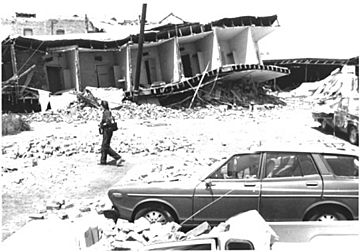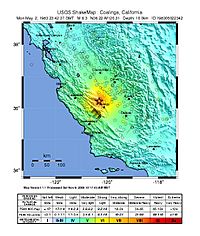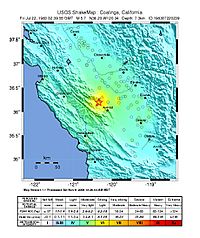1983 Coalinga earthquake facts for kids

A destroyed building on 5th Street in Coalinga
|
|
| UTC time | 1983-05-02 23:42:37 |
|---|---|
| ISC event | 575305 |
| USGS-ANSS | ComCat |
| Local date | May 2, 1983 |
| Local time | 4:42 p.m |
| Magnitude | 6.2 Mw |
| Depth | 10 kilometers (6 mi) |
| Epicenter | 36°14′N 120°19′W / 36.23°N 120.31°W |
| Type | Blind thrust |
| Areas affected | Central California United States |
| Total damage | $10 million USD |
| Max. intensity | VIII (Severe) |
| Landslides | Yes |
| Aftershocks | 5.9 Mw July 22 at 02:39 |
| Casualties | 94 injured |
The 1983 Coalinga earthquake happened on Monday, May 2, at 4:42 p.m. It struck near Coalinga, California. This earthquake was quite strong.
People felt the shaking from the Greater Los Angeles Area all the way north to Susanville. It was also felt between the Pacific Coast and western Nevada. Over 5,000 smaller quakes, called aftershocks, followed the main earthquake. About 894 of these aftershocks were strong enough to be noticed. The main quake measured 6.2 on the moment magnitude scale. Its shaking intensity was rated as VIII (Severe) on the Mercalli intensity scale.
Contents
What Caused the Coalinga Earthquake?
The Coalinga earthquake happened because a part of the Earth's surface moved upwards by about 0.5 meters. This uplift created a fold in the rock layers called an anticline ridge northeast of Coalinga. Even though the ground moved a lot underground, no new cracks or breaks appeared on the surface right away.
Right after the quake, experts looked closely at the ground. They found small cracks and fissures within about 10 kilometers (6 miles) of where the earthquake started. These cracks did not seem to be from deep faults (breaks in the Earth's crust). However, about five weeks later, an aftershock caused new cracks on the surface about 12 kilometers (7.5 miles) northwest of Coalinga.
How Much Damage Did the Earthquake Cause?
The earthquake caused about $10 million in damage. It also injured 94 people. The worst damage was in downtown Coalinga. The main shopping area, which was eight blocks long, was almost completely destroyed. Many old buildings made of brick without extra support were hit the hardest. Newer buildings, like banks, had only minor damage. Outside Coalinga, the town of Avenal, about 31 kilometers (19 miles) southeast, also had significant damage.
The American Red Cross looked at all the damage. They reported that 309 single-family homes and 33 apartment buildings were almost destroyed. Another 558 homes, 94 mobile homes, and 39 apartment buildings had major damage. Many other buildings had minor damage. Most public buildings, like the City Hall, hospital, schools, and police station, had only minor damage.
Six bridges in the area were also damaged. They had small cracks and pieces breaking off their support columns. Some parts of the bridges, like parapets (low walls), were broken or moved. The ground under some parts of the bridges also sank.
All public services were affected. The water system still worked, but it had many leaks. Gas was turned off for several days because of broken pipes. Electricity and phone services had only short interruptions. A large old concrete sewer pipe partly collapsed but kept working.
In the oil fields near Coalinga, equipment like pumping units, storage tanks, and pipelines were damaged. An oil company office building, about 7 kilometers (4 miles) north of Coalinga, was badly damaged. Its two brick chimneys fell down. Underground, 14 oil wells had damaged casings (the pipes that line the wells).
What Happened to the Ground?
The earthquake caused thousands of rock falls and rock slides. These happened as far as 34 kilometers (21 miles) northwest, 15 kilometers (9 miles) south, and 26 kilometers (16 miles) southwest of where the earthquake started. Not many landslides happened east of the earthquake's center because there were no steep hills in that direction.
What Happened After the Earthquake?
The California Seismic Safety Commission studied the earthquake. They helped Coalinga get money and expert advice to plan and rebuild. Coalinga was able to get back 98 percent of the money it spent to fix and rebuild public buildings. This was a great success, as usually only 85 percent was recovered.
The Coalinga earthquake taught geologists (scientists who study the Earth) an important lesson. It showed that California might be in more danger from earthquakes than they first thought. Scientists realized they needed to study more about how often earthquakes happen along the Pacific coast. They also became worried about earthquakes coming from faults that were not known before. California officials said that a predicted "great" earthquake would cause much more damage than this one. If such a quake hit a crowded area, the damage would be huge.



